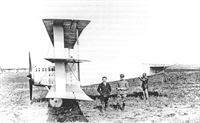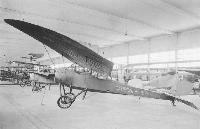
| Самолеты (сортировка по:) | |||||
| Страна | Конструктор | Название | Год | Фото | Текст |
Caproni Ca.53

|
Страна: Италия Год: 1917
|
| Caproni - Ca.5 (Ca.44 - Ca.47) - 1917 - Италия | <– | –> | Caproni - Ca.48 - 1918 - Италия |
 |
R.Abate, G.Alegi, G.Apostolo - Aeroplani Caproni: Gianni Caproni and His Aircraft, 1910-1983 |
| In 1917 the Technical Direction of Military Aviation asked for a fast bomber with a Fiat A.14 engine, capable of carrying a 400 kg bomb load at speeds around 200 km per hour. The Caproni design, later labelled Ca.53, had a big wooden fuselage and triplane wings. Performance estimates were not met, in part because the A.14 was replaced with a heavier 450 hp Tosi V-12. Committed to Ca.5 production, the company could not support a full development effort and the project was abandoned. The sole prototype is now with the Caproni Museum. |
 |
J.Davilla - Italian Aviation in the First World War. Vol.2: Aircraft A-H /Centennial Perspective/ (74) |
| Caproni Ca.53. |
 |
J.Davilla - Italian Aviation in the First World War. Vol.2: Aircraft A-H /Centennial Perspective/ (74) |
| Caproni Ca.53. |
 |
J.Davilla - Italian Aviation in the First World War. Vol.2: Aircraft A-H /Centennial Perspective/ (74) |
| Caproni Ca.53 rear view. |
 |
J.Davilla - Italian Aviation in the First World War. Vol.2: Aircraft A-H /Centennial Perspective/ (74) |
| Caproni Ca.53 front view. |
 |
R.Abate, G.Alegi, G.Apostolo - Aeroplani Caproni: Gianni Caproni and His Aircraft, 1910-1983 |
| The importance and quantity of the material gathered by the Capronis soon required the construction of a permanent display structure, designed along a coherent historical perspective. The Caproni Museum thus occupied a large hangar on Taliedo airport, among the firm’s workshops. In this area were placed the Caproni Ca.1, Ca.6, Caproni Bristol, Ca.18, Ca.20, Ca.22, Ca.36M, Ca.42, Ca.53, elements of the Ca.60, Gino Allegri’s Ansaldo SVA serial 11777, the CNA Eta, a Fokker D.VIII fuselage, two Gabardini monoplanes, one of which with floats, a Gabardini G.51, a Macchi-Nieuport 29, a Roland VIb fuselage, a Siemens Schuckert D.IV forward section, tre airship gondolas, a model of Leonardo da Vinci’s unbuilt glider, plus an unspecified number of engines, propellers, and other material. This was certainly among the world’s largest aviation collections, much admired by the many illustrious visitors. The photo shows the Ca.22 and, behind it, the Ca.53. Between the two the uncovered fuselage and rudder of the Caproni-Bristol can be seen. |